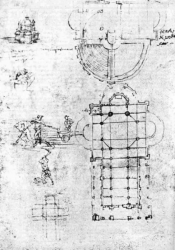Architecture - da Vinci and Humanism
Leonardo da Vinci was inspired to create church drawings after Milan's authorities wanted someone to design a tower for the cathedral. Influenced by the works of both Bramante and di Giorgio, he drew numerous designs that placed emphasis not only on symmetry using geometric shapes, but on the connection between human and nature. These ideas stem from the mind of a Roman architect named Vitruvius. He is most notable for The Vitruvian Man, which states that the human, who is perfectly inscribed in a circle and a square, fits a certain ratio that universally exists in nature. da Vinci's own version of The Vitruvian Man represents those ideas but is mathematically more accurate in its depiction. His church sketches were indicative of the ideas of humanism intertwined with mathematics as the church layout resembles that of a human body, which can be inferred that the church is universally connected with nature.
Sources:
Craven, Jackie. “Hidden Codes: How Geometry Shapes Architecture.” ThoughtCo, ThoughtCo, 3 July 2019, www.thoughtco.com/geometry-and-architecture-178081.
Isaacson, Walter. Leonardo Da Vinci. Simon & Schuster, 2017.
Laurenza, Domenico. “The Vitruvian Man by Leonardo: Image and Text.” Quaderni d’italianistica, vol. 27, no. 2, Sept. 2006, pp. 37–56. EBSCOhost, search.ebscohost.com/login.aspx?direct=true&db=hlh&AN=23474641&site=eds-live.
Image: https://www.researchgate.net/profile/Joao_Xavier2/publication/226963956/...@1451160978407

